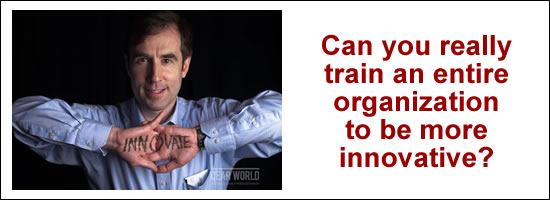Inspired by Hollywood

GUEST POST from Robyn Bolton
What happened the last time you asked your team for ideas?
A. Nothing. Nada. Zip. Zilch.
B. Got some ideas but nothing new or noteworthy
C. Got lots of ideas, but very few were relevant, new, or big
D. The clouds parted. The angels sang. The Ideas forever transformed our business.
My guess is you answered A, B, or C
(If you answered D, let me know because I need to learn how you did it).
While there are dozens of reasons why D did not happen, the most common one is this:
You asked for ideas.
You said, “Hey, I want to hear your ideas.”
Or maybe you got more specific and said, “I want to hear your ideas about how we can do better.”
What your team heard was “Hey, I want to hear your ideas as long as they’re the ideas I want to hear and pertain to the topics I want to hear about, but I’m not going to tell you the topics, so share at your own risk and may the odds be ever in your favor.”
So your team stayed quiet.
Good news, you can turn the odds in your favor if you do this ONE thing:
Give them constraints.
It seems counterintuitive.
After all, shouldn’t creativity be unconstrained?
Isn’t ideation all about blue sky crazy thinking?
Doesn’t innovation require us to unshackle ourselves from what is practical and dream of what’s possible?
No. No. No.
Constraints fuel creativity
You don’t have infinite money, people, or time. *
Which means you have constraints.
Don’t run from that fact. Don’t hide from it. Don’t ignore it,
Embrace it because it is what fuels creation, innovation, and growth.
No one knew that better than Orson Welles (and he was a pretty creative guy)
“The enemy of art is the absence of limitations,” he told filmmaker Henry Jaglom. “Economically and creatively, that’s the most important advice you can be given. You have limitations; you don’t have $ 1 million to blow up that bridge, so you have to create something else on film to produce the same effect. Instead of having money to hire hundreds of extras, you have to sneak a cameraman in a wheelchair through the streets of New York City and steal the shot, which gives you a look of much greater reality.”
If constraints can create Citizen Kane, imagine what they can do for your business.
Constraints demand focus
Think about the last movie you saw that was way too long. Or the book that could have been an article. Or the meeting that should have been an email.
When you have all the money, time, or resources you need, you can do anything and try to do everything. Unfortunately, the result is usually a bloated confusing mess that leaves your customers feeling like they’ve lost more than they gained.
But when you only have 2 hours or 300 pages to tell a story, 20 minutes instead of four hours for a presentation, or $10,000 to create a new product, you get crystal clear on what you’re trying to accomplish, prioritize what you need, and leave everything else behind.
Constraints cause tension which leads to choices
In The Offer, a fantastic series about the making of The Godfather, there’s a great scene in which the studio executive demands that Francis Ford Coppola cut 45 minutes from the film (and helpfully suggests cutting all the scenes set in Sicily). The reason? So that theaters can host five showings per day instead of four.
Two hours is a constraint.
Sicily is where Michael abandons all hope of a normal life.
The tension between revenue and story, business and art, is real.
Tension requires you to make choices. Constraints shouldn’t always win. But they should always be present.
Constraints create value
The next time you ask for ideas sprinkle in some constraints.
- “I’d like your ideas for how we can use existing assets to expand into new markets.”
- “How can we earn more money from existing customers without raising prices?”
- “What can we stop doing so we can focus on high-priority work and avoid burnout?”
You’ll find that adding a few constraints to your request for ideas will be an offer your team can’t refuse.
*If you do have unlimited people, money, and time, please let me know. I’d love to talk to you.
Image credit: Unsplash
![]() Sign up here to get Human-Centered Change & Innovation Weekly delivered to your inbox every week.
Sign up here to get Human-Centered Change & Innovation Weekly delivered to your inbox every week.




 OK, it may not really be an innovation, but I appreciated the following operational efficiency anyway:
OK, it may not really be an innovation, but I appreciated the following operational efficiency anyway: